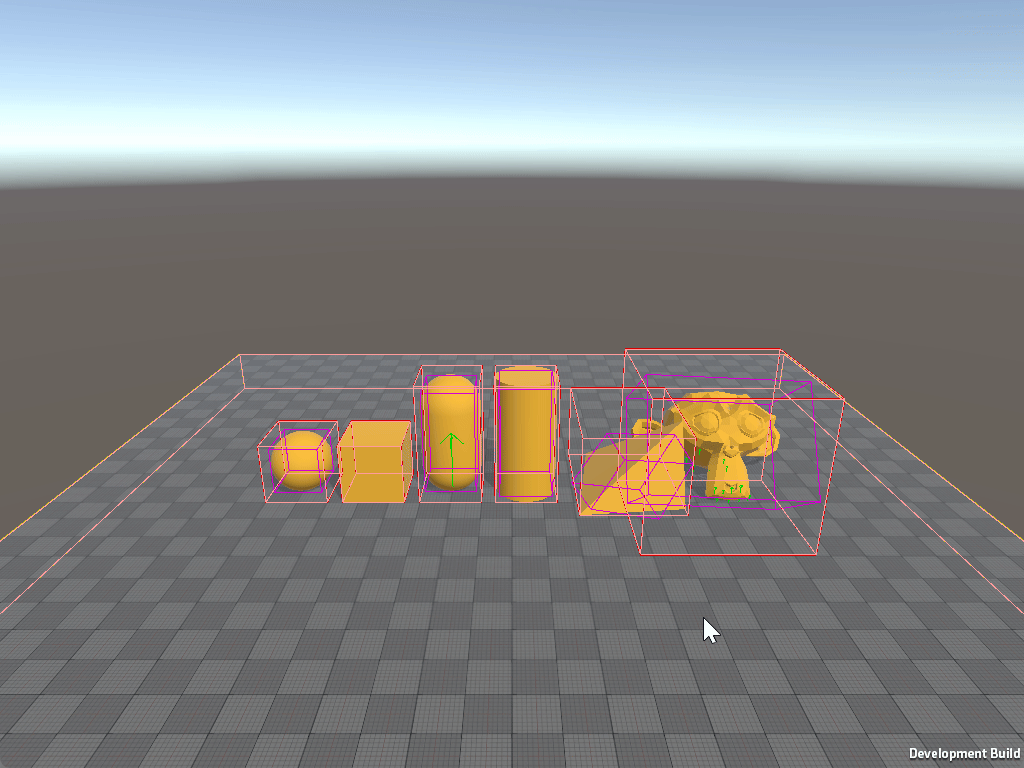Physics Debug Display
To visualise Unity Physics, add a Physics Debug Display component. As usual, when working with Entities, a SubScene is necessary when adding the Physics Debug Display component.
| Field | Description |
|---|---|
| Draw Colliders | Displays a solid collider around the object. |
| Draw Collider Edges | Displays only the edges of the collider. |
| Draw Collider AABBs | Displays the collider's Axis Aligned Bounding Box (AABB), which is usually used in the broadphase. |
| Draw Broadphase | Displays the Broadphase expanding the AABB's bodies colliders caused by the collision detection between two bodies. While Draw Collider AABB's does not. |
| Draw Mass Properties | Displays the mass properties. |
| Draw Contacts | Displays a visualization of all contacts. |
| Draw Collision Events | Displays a visualization of all collision events. |
| Draw Trigger Events | Displays a visualization of all trigger events. |
| Draw Joints | Displays a visualization of all Joints, with degrees of freedom, constraints, anchor points and axis alignments. |

Physics Debug Display component.
Physics Debug Display at Runtime
Enabling Physics Debug Display
To enable the Physics Debug Display component in Player builds:
- Navigate to Edit > Project Settings > Physics > Unity Physics.
- Check Enable Player Debug Display project setting, or manually add the
ENABLE_UNITY_PHYSICS_RUNTIME_DEBUG_DISPLAYscripting define symbol to your Player settings.
Important Notes
Using PhysicsDebugDisplayData will help debugging physics behavior directly in-game if required. However, this debugger may impact performance, so avoid using ENABLE_UNITY_PHYSICS_RUNTIME_DEBUG_DISPLAY outside of development builds or for debugging purposes only.
Toggling Parameters at Runtime
The following script demonstrates how to modify PhysicsDebugDisplayData at runtime by accessing the component and updating its values as needed. Refer to the table above to enable or disable specific debug options.
#if ENABLE_UNITY_PHYSICS_RUNTIME_DEBUG_DISPLAY
using Unity.Burst;
using Unity.Entities;
using Unity.Physics.Authoring;
using UnityEngine;
[RequireMatchingQueriesForUpdate]
[UpdateInGroup(typeof(PhysicsDebugDisplayGroup))]
[BurstCompile]
partial struct RuntimePhysicsDebugDisplayDataManager : ISystem
{
[BurstCompile]
public void OnCreate(ref SystemState state)
{
state.RequireForUpdate<PhysicsDebugDisplayData>();
}
[BurstCompile]
public void OnUpdate(ref SystemState state)
{
var debugDisplayData = SystemAPI.GetSingleton<PhysicsDebugDisplayData>();
if (Input.GetKeyDown(KeyCode.Alpha1))
debugDisplayData.DrawColliders ^= 1;
if (Input.GetKeyDown(KeyCode.Alpha2))
debugDisplayData.DrawColliderEdges ^= 1;
if (Input.GetKeyDown(KeyCode.Alpha3))
debugDisplayData.DrawContacts ^= 1;
// Enable others:
//debugDisplayData.DrawCollisionEvents ^= 1;
//debugDisplayData.DrawColliderAabbs ^= 1;
//debugDisplayData.DrawTriggerEvents ^= 1;
//debugDisplayData.DrawJoints ^= 1;
//debugDisplayData.DrawMassProperties ^= 1;
//debugDisplayData.DrawBroadphase ^= 1;
//debugDisplayData.ColliderEdgesDisplayMode = (PhysicsDebugDisplayMode)((byte)debugDisplayData.ColliderEdgesDisplayMode ^ 1);
//debugDisplayData.ColliderAabbDisplayMode = (PhysicsDebugDisplayMode)((byte)debugDisplayData.ColliderAabbDisplayMode ^ 1);
//debugDisplayData.ColliderDisplayMode = (PhysicsDebugDisplayMode)((byte)debugDisplayData.ColliderDisplayMode ^ 1);
SystemAPI.SetSingleton(debugDisplayData);
}
}
#endif
